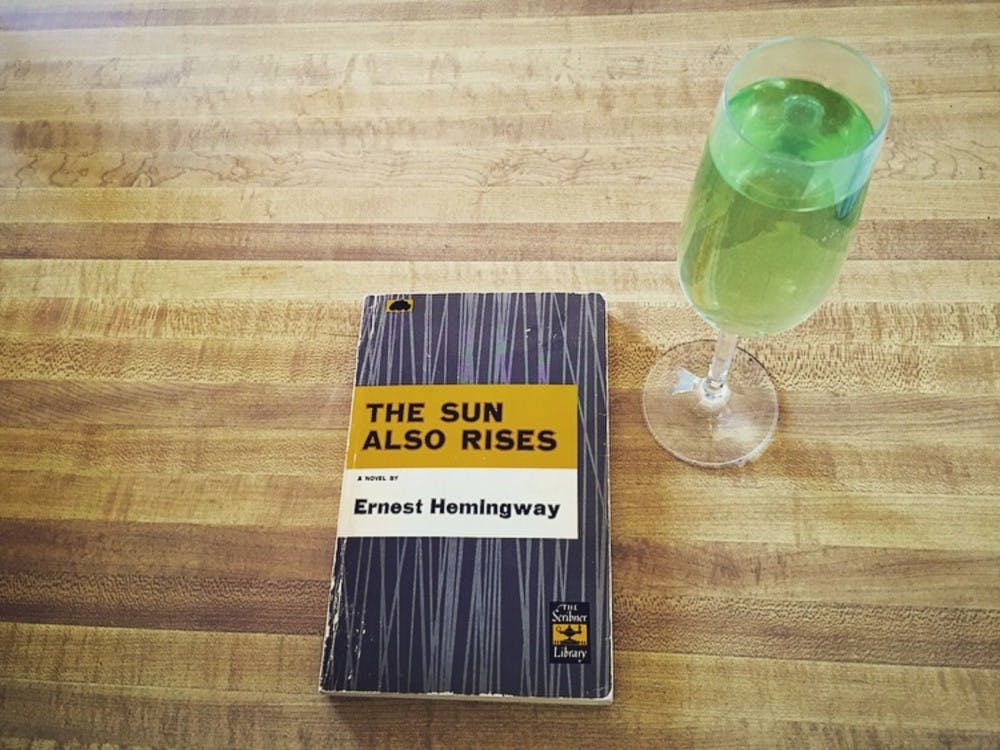Each week reporter Carson Abernethy drinks his way through great works of literature, reviewing books and the booze that inspired them.
Born out of World War I, the Lost Generation consisted of some of the greatest writers and artists of the 20th century. Dissatisfied with the U.S., many fell for the allure of Paris, which is reflected in Hemingway's "The Sun Also Rises."
Booze definitely had an influence on the composition of the novel, as Hemingway was a famously avid consumer of it. He was the creator of a number of drinks, and if he didn't invent it he at least put his own twist on it. One of the drinks that features most prominently in "The Sun Also Rises" is absinthe.
Absinthe is an anise flavored spirit with a long and torrid history. It was a favorite of bohemian artists and writers in the late 19th and early 20th centuries. It was nicknamed the "green fairy."
However, shoddy science led to the false belief that ingredients in absinthe caused hallucinations, and it was banned in places like the U.S. and France in 1915. With the 1990s came a resurgence in the interest in absinthe, and in 2007, it was made legal again in the U.S.
While absinthe today is a poor replacement for the absinthe Hemingway drank, mediocre absinthe is better than no absinthe at all.
One of Hemingway's classic cocktail creations called "Death in the Afternoon" named after his book on bullfighting. Consisting of just absinthe and champagne, Death in the Afternoon is as simple as it is potent.
Recipe:
- 1 1/2 oz. absinthe
- 1 flute champagne
Add a jigger of absinthe to a flute of champagne. Hemingway recommended drinking three to five — slowly. If you can make it through that, you're truly a drinker of Hemingway's caliber.
"The Sun Also Rises" explores the cafe society of Paris in the '20s and a group of friends who journey from Paris to Spain to watch the running of the bulls.
Prose: 4.5/5
Hemingway's method of writing prose is some of the best known in all of literature. His iceberg theory, or theory of omission, traded very subjective and descriptive prose for objective and journalistic brevity. Just like an iceberg, only a small amount of the meaning is seen on the surface, layers of depth are in the subtext.
The reader has to work to understand Hemingway, and in that sense he can be both the easiest and the hardest writer to understand. While his prose is not as beautiful or ornate as some of his contemporaries, like Fitzgerald, he had a unique and successful Modernist vision.
Characterization: 4/5
Hemingway's characters, like Kerouac's after him, were drawn from real people. In fact, the publication of this novel caused quite a scandal in Paris circles because many of the people who were loosely fictionalized were not so flattered with their characterizations.
Jake Barnes, the protagonist, is a writer made impotent by the war. Lady Brett is his ill-fated love interest; she embodies the burgeoning sexuality of women at the time, shown through her bob and her string of lovers. Both are deeply flawed characters, but also the two most interesting. They really carry the novel.
The character of Cohn, a Jewish college friend of Barnes', is the recipient of the many anti-Semitic remarks in the novel, and his characterization (reviled for no other reason than being Jewish) is troubling.
Cohesiveness: 4.5/5
The book has a rather simple three part structure: book one is Barnes and his friends drinking in Paris, book two is Barnes and his friends drinking in Spain and book three is the aftermath of the fiesta and all the drinking.
While simple in structure, it works quite well in execution. Another interesting part of the structure is that the novel does not have a clear beginning, and no backstory is provided.
Fitzgerald had advised Hemingway to cut some of the first 30 pages of the novel, but Hemingway cut them all out instead, making for a very unique starting point.
Relevance: 5/5
The Lost Generation has a lot of parallels with the generations arising in the 20th century, who are also lost, disillusioned and changed by war. But, Hemingway showed in the novel that the damage done to his generation was not irreparable. They were not as lost as everyone thought; they were resilient. The same can be said of today's generation.
Overall: 4.75/5
Hemingway’s first book is arguably his best, and probably the source of his most enduring legacy. One of the greatest works of the Lost Generation and the 20th century in general, "The Sun Also Rises" still resonates today, even if it’s far from the seedy nightclubs of Paris and the bulls and fiestas of Spain.
Related Links:
Books & Booze: 'On the Road' by Jack Kerouac
New Jonathan Franzen book 'Purity' takes on feminism through traditional book format
Reach the reporter at cabernet@asu.edu or follow @carson_ab on Twitter.
Like The State Press on Facebook and follow @statepress on Twitter.




